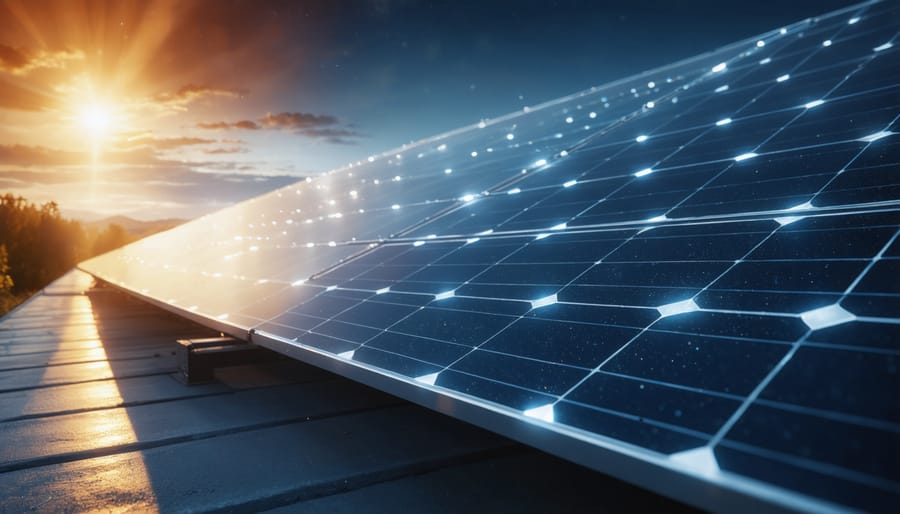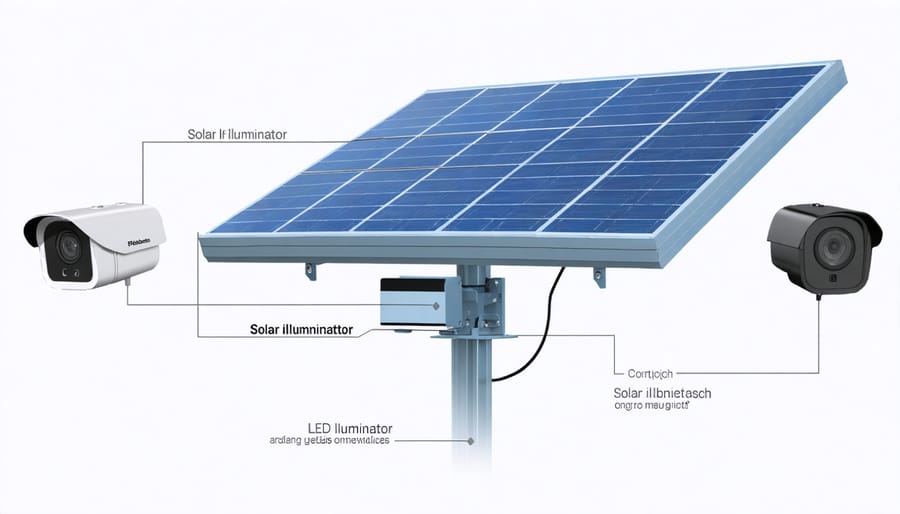Solar-Powered IR Illuminators: Smart Night Vision That Never Sleeps

Solar-powered IR illuminators represent a groundbreaking fusion of renewable energy and security technology, transforming how we approach nighttime surveillance and monitoring. These innovative devices harness daylight through high-efficiency photovoltaic cells to power infrared LED arrays, delivering reliable illumination without conventional power sources. As a cornerstone of modern solar power lighting solutions, these systems combine sophisticated energy storage mechanisms with precision-engineered infrared emitters, operating autonomously throughout the night while maintaining zero operational carbon footprint.
By converting solar energy into stored electrical power and subsequently into invisible infrared light, these illuminators create a self-sustaining security ecosystem that’s particularly valuable across European installations where sustainable technology integration is paramount. Their ability to function independently of grid power while providing consistent, weather-resistant illumination has made them essential components in both residential security systems and commercial surveillance applications.
The Core Components of Solar IR Illuminators

Solar Panels and Energy Collection
Solar-powered IR illuminators rely on high-efficiency photovoltaic panels specifically designed for optimal energy harvesting. These panels utilize monocrystalline or polycrystalline silicon cells that convert sunlight into electrical energy through the photovoltaic effect. The panels are typically optimised for both direct and diffused light collection, ensuring reliable performance even in European climates with variable weather conditions.
Modern solar panels used in IR illuminators feature anti-reflective coatings and precise cell arrangements that maximise energy capture during daylight hours. This collected energy is then converted from DC power to the specific voltage requirements of the IR LED array. Advanced models incorporate maximum power point tracking (MPPT) technology to optimise energy collection throughout the day, ensuring efficient power generation even during periods of lower solar intensity.
Battery Storage Systems
Battery storage systems are crucial components that enable solar-powered IR illuminators to function reliably after sunset. High-capacity lithium-ion batteries store excess solar energy generated during daylight hours, ensuring consistent performance throughout the night. Modern storage solutions typically incorporate smart charging controllers that optimize energy collection and protect the batteries from overcharging or excessive discharge.
For European installations, weather-resistant battery enclosures are essential, designed to withstand varied climate conditions while maintaining optimal operating temperatures. Most systems include monitoring capabilities that allow users to track battery levels and system performance via digital displays or smartphone applications. The storage capacity is typically sized to provide 8-12 hours of continuous illumination, with some advanced systems offering extended backup power for cloudy periods.
When selecting a battery storage system, consider factors such as depth of discharge, cycle life, and maintenance requirements to ensure long-term reliability and cost-effectiveness.
IR LED Arrays
IR LED arrays form the heart of modern illuminators, consisting of carefully arranged infrared light-emitting diodes that produce invisible light at wavelengths between 850-940nm. These arrays typically feature multiple high-efficiency LEDs mounted on specialized circuit boards with heat-dissipating materials. The configuration of these LEDs determines the illumination angle and coverage area, with most commercial systems offering beam angles from 30° to 120°. Modern arrays incorporate advanced optical designs and precise thermal management to maximize light output while maintaining long-term reliability. The latest European-standard IR LED arrays achieve impressive efficiency ratings, converting up to 70% of input power into usable infrared light, making them ideal for solar-powered applications where energy efficiency is paramount.

Working Principles and Operation
Daytime Energy Collection
Solar-powered IR illuminators rely on efficient daytime energy collection to power their nighttime operations. The process begins with high-quality photovoltaic panels, typically monocrystalline or polycrystalline silicon cells, which convert sunlight into electrical energy. These panels are strategically positioned to maximise solar exposure, often at a 30-45 degree angle in most European locations.
During daylight hours, the solar panels capture both direct and diffused sunlight, converting photons into electrical current through the photovoltaic effect. This process generates DC (Direct Current) electricity, which is then regulated through a charge controller to prevent overcharging and ensure optimal battery life.
The harvested energy undergoes careful voltage regulation before being stored in dedicated batteries, commonly lithium-ion or AGM (Absorbed Glass Mat) types, selected for their reliability and performance in European climate conditions. Modern systems typically incorporate MPPT (Maximum Power Point Tracking) technology, which optimises the conversion efficiency by adjusting the electrical operating point of the solar panel.
The energy collection system also features protective mechanisms against common European weather challenges, including automatic shutdown during extreme conditions and bypass diodes that maintain partial functionality even when some cells are shaded. This ensures consistent energy harvesting throughout varying seasonal conditions, from the bright summer months to shorter winter days.
Nighttime Illumination
During nighttime operation, solar-powered IR illuminators rely on sophisticated energy management systems to deliver reliable solar-powered illumination. The process begins with the energy stored in high-capacity batteries during daylight hours. These advanced battery systems, typically lithium-ion or LiFePO4, efficiently distribute power to the IR LED arrays when ambient light levels drop below predetermined thresholds.
A charge controller manages the power flow, ensuring optimal energy distribution throughout the night. This intelligent system monitors battery levels and adjusts LED intensity accordingly, maximizing operational duration while maintaining effective illumination. Most modern units employ pulse-width modulation (PWM) technology to regulate power consumption, allowing the illuminator to function efficiently for 8-12 hours on a full charge.
The IR LEDs themselves are arranged in strategic configurations to provide maximum coverage while minimizing energy consumption. These arrays typically operate in the 850nm or 940nm wavelength range, invisible to the human eye but perfect for night vision applications. Advanced models feature adaptive brightness controls that respond to movement or scheduling requirements, further optimizing energy usage.
To ensure year-round functionality, particularly during shorter winter days in European locations, the battery capacity and solar panel sizing are carefully calculated to maintain consistent performance even during extended periods of reduced sunlight.
Installation and Optimization
Placement Considerations
Optimal placement of solar-powered IR illuminators requires careful consideration of both the solar panel and illuminator positioning. The solar panel should face south in the Northern Hemisphere (or north in the Southern Hemisphere) at an angle between 30-45 degrees for maximum sun exposure. Ensure there are no obstructions like trees, buildings, or architectural features that could cast shadows on the panel during peak sunlight hours.
For the illuminator itself, mount it at a height of 2.5 to 4 metres, angling it slightly downward to cover the intended surveillance area effectively. Consider the illuminator’s beam angle and range when determining placement, typically aiming to cover entrance points, pathways, or specific security zones.
Weather protection is crucial for both components. Install the solar panel where it won’t accumulate snow or debris, and position the illuminator under eaves or with protective housing when possible. For optimal performance in European climates, factor in seasonal variations in daylight hours when calculating panel size and battery capacity.
Avoid placing illuminators where they might cause glare or light pollution affecting neighbours or public spaces. Consider using multiple smaller units rather than one powerful illuminator for more even coverage and better reliability.

Maintenance Requirements
Regular solar lighting maintenance is crucial for ensuring optimal performance of your IR illuminators. Start by cleaning the solar panels monthly using a soft, damp cloth to remove dust, debris, and bird droppings that can reduce charging efficiency. During winter months, check more frequently to clear snow or ice accumulation.
Inspect the IR LEDs quarterly for any physical damage or debris that might obstruct the infrared beam. Clean the LED array carefully with a microfibre cloth to maintain maximum illumination power. Check all weatherproof seals and gaskets annually to prevent moisture ingress, which can damage internal components.
Monitor the battery performance by observing charging patterns and runtime duration. Most systems use lithium-ion batteries that typically need replacement every 3-5 years, depending on usage patterns and environmental conditions. Keep vegetation trimmed around the unit to prevent shadowing of the solar panel and ensure unobstructed IR beam projection.
Document all maintenance activities and battery replacement dates for warranty purposes and performance tracking. Consider professional servicing annually, especially for commercial installations where consistent performance is critical for security operations.
European Applications and Benefits
In Europe, solar-powered IR illuminators have found significant traction due to the region’s strong commitment to sustainable technology and varying daylight conditions. These systems prove particularly valuable in Nordic countries, where winter brings extended periods of darkness, yet summer offers abundant solar charging opportunities. Many European businesses and homeowners integrate these illuminators into their security systems, capitalizing on the continent’s well-developed solar infrastructure.
The technology aligns perfectly with EU energy efficiency directives, offering substantial cost savings while contributing to carbon reduction goals. In countries like Germany, France, and the Netherlands, solar-powered IR illuminators are increasingly deployed in agricultural settings for livestock monitoring and crop security. Urban applications include surveillance of public spaces, parking facilities, and historical sites, where traditional power infrastructure modifications would be costly or restricted.
A notable benefit in European contexts is the systems’ resilience during power outages, which is particularly valuable in remote Alpine regions or coastal areas prone to severe weather events. The integration with smart city initiatives across European metropolitan areas has demonstrated how these illuminators can enhance public safety while maintaining energy independence.
Installation costs are often offset by various EU and national-level renewable energy incentives, making the technology increasingly accessible to both private and commercial users. The systems’ minimal maintenance requirements and long operational life align well with European sustainability standards and circular economy principles.
Solar-powered IR illuminators represent a significant advancement in sustainable security technology, combining renewable energy with efficient night vision capabilities. As we’ve explored, these systems work through the seamless integration of solar panels, battery storage, and IR LED technology, providing reliable illumination while minimizing environmental impact and operating costs. The future outlook for this technology is particularly promising in the European market, where increasing focus on energy efficiency and security needs drives innovation. With ongoing improvements in solar cell efficiency and LED technology, we can expect to see even more powerful and cost-effective solutions emerging. For property owners and businesses considering security upgrades, solar-powered IR illuminators offer a sustainable, low-maintenance solution that aligns perfectly with Europe’s green energy initiatives while delivering dependable security performance.
Leave a Reply